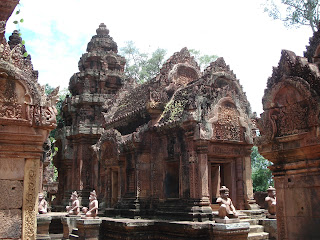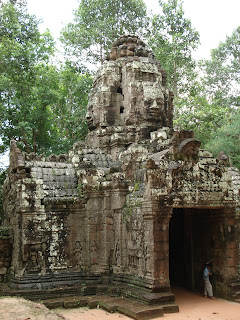We visited Pre Rup, which was built as the state temple of Khmer king Rajendravarman and dedicated in 961 or early 962. It is a temple mountain of combined brick, laterite and sandstone construction.
The steps leading up to the top were incredibly steep, but worth the hike.
After leaving Pre Rup, we travelled a long distance to visit another temple, Banteay Srei. Though much smaller in size, this complex of buildings is one of the most unique in all the world because of the intricacy of the stone carvings that cover the walls.
Banteay Srei is a 10th century Cambodian temple dedicated to the Hindu god Shiva. It lies 15 miles away from the main group of temples. The complex is built largely of red sandstone, a medium that lends itself to the elaborate decorative wall carvings which are still observable today. The buildings themselves are miniature in scale when compared to the other Angkor temples.
Next we visited the 10th century temple of East Mebon built during the reign of King Rajendravarman, it stands on what was an artificial island at the center of the now dry East Baray reservoir.
East Mebon was dedicated to the Hindu god Shiva and honors the parents of the king. Dedicated in 953 AD, it has two enclosing walls and three tiers. At the top is a central tower on a square platform, surrounded by four smaller towers at the platform’s corners.
The sculpture at East Mebon is varied and exceptional, including two-meter-high free-standing stone elephants at corners of the first and second tiers. Religious scenes include the god Indra atop his three-headed elephant Airavata, and Shiva on his mount, the sacred bull Nandi.
Visitors looking out from the upper level today are left to imagine the vast expanses of water that formerly surrounded the temple. Four landing stages at the base give reminder that the temple was once reached by boat.
After East Mebon, we started to visit the Ta Som temple...
But we got caught in another downpour of rain and escaped to have lunch at a nearby restaurant.
After the rain subsided, we continued our adventure at the unique temple of Neak Poan. Built by king Jayavarman VII before the end of the 12th century, this monument is an artificial island, measuring 350 meters on each side, built in the middle of a reservoir which is also man- made. The name, Neak Poan, comes from the motif of serpents encircling the base of the central sanctuary.
An inscription notes that it is "a sacred island, drawing its charm from its pond and clearing away the sins of those that approach it." There are, in fact, four ponds surrounding the temple. They were fed by a complex system of anthropomorphic and zoomorphic fountains.
In 1191, the king dedicated this temple to be the shelter of the idol of his father. It may have served as a temporary residence of King Jayavarman VII while he was rebuilding the capital after the Charms sacked Angkor in 1177. Preah Khan is the name of the sacred sword, the safeguard of Cambodia, which is preserved in the palace of Phnom Penh. It is among the largest monuments in the Angkor complex. It includes a set of four concentric enclosures, giant Garudas and serpents are decorated every 50m around the 3km long wall.
 |
| This stupa, built a few centuries after the temple's original construction marks center of the temple and the spot of the original statue of Lokesvara. |
 |
| The Angkor people, as part of their religion, worshiped phalic symbols. This is one of the few remaining in the temples today as most have been lost or removed for preservation. |
After our tour finished on our second day, we had a few extra hours before dusk. We decided to direct our tuk tuk driver to take us to the "floating city". We had heard it was one of the recommended sites to see outside of the Angkor complex, and at this point, we were ready to see anything that wasn't a temple. Friends had told us that years ago this "city" was a fascinating fishing community and way of life living on the shores of the river but we found the "floating city" today to be a site of true poverty. People didn't live hear to fish, they lived here because it's all they can afford and they fish because it's all they know. We didn't take many pictures as we were overwhelmed by the poverish city and many of the people asked for money in return for photos (an act common for poverish countries). We did donate some food and water to the "floating school."































No comments:
Post a Comment